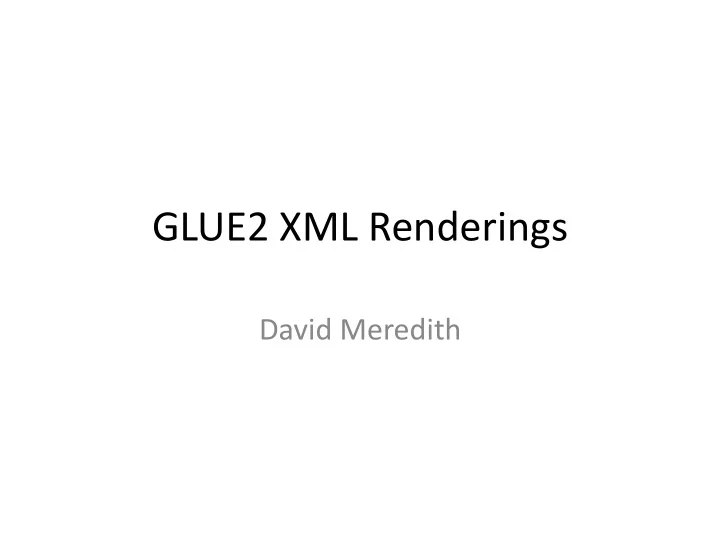

GLUE2 XML Renderings David Meredith
GLUE2: XSD Style, Flat or Nested • Flat: – Entities are equal siblings listed in a global element bag. – <Associations> modelled using 1 method: • Element ID references (all associations defined as children of <Associations> elements). • Nested: – Defines multiple Document Root elements. – <Associations> modelled using 2 methods: • Nesting (defines strong parent-child relationships) • Element ID references (a single entity can have many parents which cannot be modelled by nesting alone – GLUE2 is not a pure tree structure). • Flat voted as preferred style at OGF 35 but... • Not a complete consensus, some prefer nested. • Hope to derive a style consensus/solution soon...
GLUE2: GOCDB Requirements • Render results from Projection queries – Projection queries simply specify the entities you need to render when building a SELECT query (for SQL, you would normally specify fields/cols). • GOCDB provides 18 projection style methods: – get_service_endpoint – get_ngi – get_site – get_contact – get_downtime – get_site_contacts ...
GLUE2: GOCDB Requirements 2. 1. ~ Consider 1000’s of records = can produce large XML documents. 1) https://goc.egi.eu/gocdbpi/private/?method=get_roc_contacts&roc=NGI_UK 2) https://goc.egi.eu/gocdbpi/public/?method=get_downtime&topentity=GOCDB
Nested 1. Associations: uses both nesting + ID references (nesting can’t do many parents). 2. XSD enforces nested relationships. 3. Easy doc traversal for many associations (i.e. XPath to select nested children rather than cross referencing) 4. Can’t project/select only the required entities without using multiple Doc roots. 5. Redundant parent + sibling elements = bloated docs (consider 1000s of records). • Could exclude optional siblings and optional parents which are redundant, but this is misleading (entities MUST always be rendered in full). ( ... detail elided)
Flat XSD <Entities> is Document Root: (element bag that lists GLUE entities as siblings in a defined order). Elements declared globally and referenced from within <Entities>. GLUE elements can be imported into standalone in 3 rd party XSD.
Flat 1. Single Doc Root element (<Entities>). 2. Relationships modelled using one method; (ID references which caters for many-to-many parents – GLUE2 is not a pure tree structure!). 3. Weaker association (relationship is not enforced by XSD = extra coding effort to validate that a reference points to correct element). 4. Traversing associations requires sub-queries (cross referencing element IDs) 5. Supports Bi and Uni directional associations. 6. Efficient = project just the required entities (e.g. select all contacts, select all endpoints etc). (elements are collapsed)
Sample Flat Rendering (projecting services and endpoints) • Can select/render (project) just the required entities under the same Doc root. • Efficient: No redundant data (consider 1000s of records). • When selecting multiple entities (e.g. ‘select * services, endpoints, Contacts for NGI_X’) its harder to traverse the associations in the results (lots of ID lookups).
Flat XSD All associations are element ID references ID References to endpoints Sample XML
Nested All XSD associations are directly nested Inner (nested) Sample XML endpoint s
Q. Should we consider a combined approach that enables a choice of nesting and/or element ID referencing according to the rendering requirements?
Combined Approach (Nested +Refs) Associations Note, a nested can be directly ‘<Service>’ association nested and/or is not suitable here referenced (thus only provide <ServiceID> option) 2 Referenced Sample XML + 1 Nested endpoints
Combined Approach • Single XSD for both styles • <Entities> as single + consistent Doc Root element. – <Child_Entity_Elements> can then nest their associated elements, or reference other entity elements to suit use cases, i.e. • Use Element refs to render projection queries • Use Nesting for other (eg XPath friendly) renderings • Combined approach is not new (its quite common); e.g. Spring framework caters for both Inner Beans + Bean references in ‘spring - beans.xml’ in exact same way. • Explicit Validation Rule: – MUST fail if a duplicate <Element> exists with same ID in doc. • But, is this too flexible/complex? – Would need to be selective where we offer a choice of nested/idref ; in some associations, a choice is not necessary (see previous slide). Note, it is possible to refine the combined approach e.g. using <xsd:choice> if necessary. – Implementations would need to be clear if they require/support a particular style (a profiling requirement ?).
Recommend
More recommend